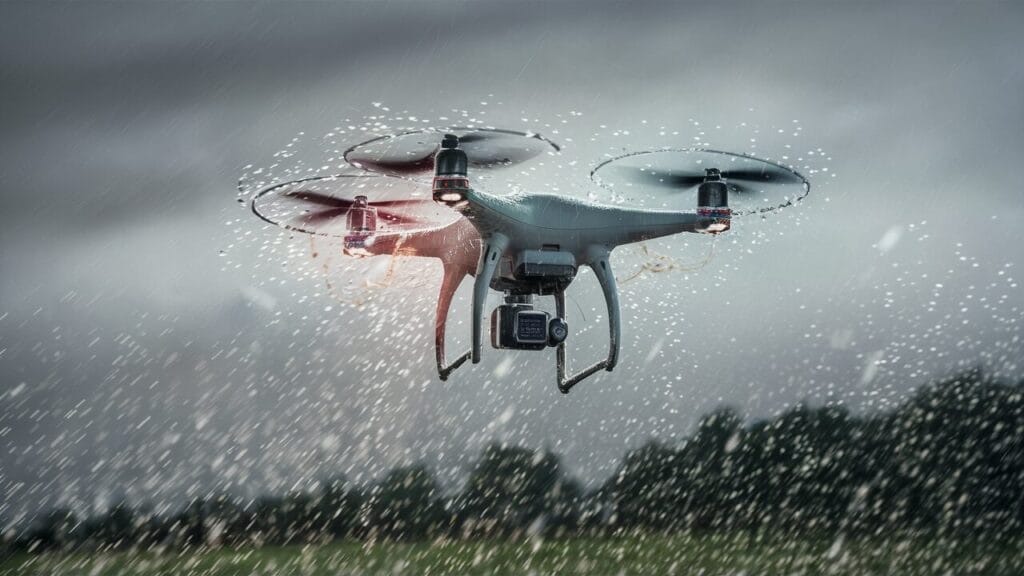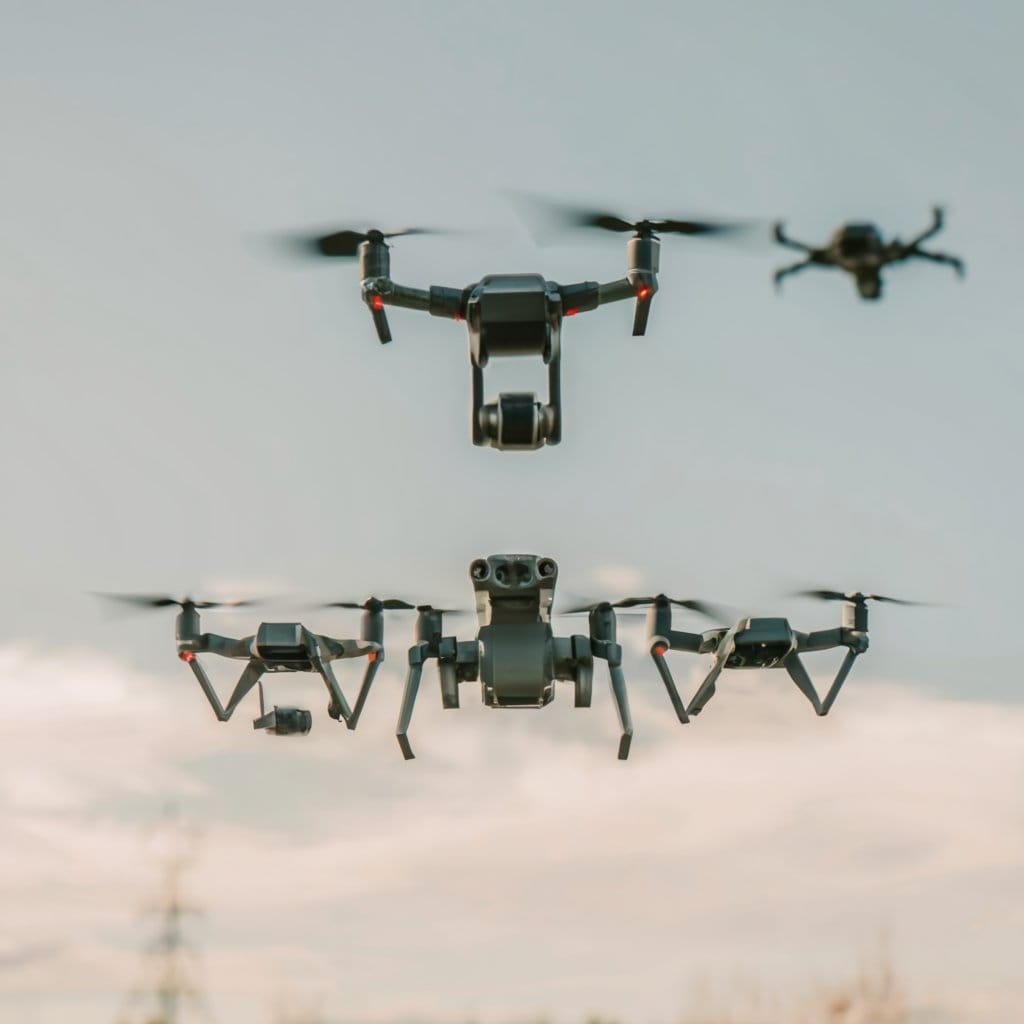Have you ever wondered if drones can operate in rainy conditions? This blog post delves into the intriguing question, can drones fly in rain, examining the challenges and possibilities? Despite their technological advancements, drones face significant limitations when it comes to adverse weather conditions like rain. Understanding the impact of moisture on drone components is crucial for safe and efficient operations. Join us as we explore the factors that determine a drone’s ability to function in rainy weather, shedding light on this captivating aspect of drone technology.

Understanding IP Ratings
Definition of IP Ratings
IP ratings, or Ingress Protection ratings, are standards set to define the level of protection provided by electronic devices against intrusion from solids and liquids. These ratings consist of the letters “IP” followed by two digits.
IP ratings are crucial for determining the suitability of electronic devices, including drones, for different environments and weather conditions. The first digit in an IP rating signifies the protection level against solids, while the second digit indicates protection against liquids.
Significance of IP Ratings for Drones
For drones operating in various weather conditions, especially rain, understanding IP ratings is essential. Drones with higher IP ratings offer better protection against water ingress, ensuring safe operation even in rainy conditions.
When it comes to flying drones in rain, selecting a model with an appropriate IP rating becomes imperative. Higher IP ratings, such as IP67 or IP68, provide increased protection against water exposure, preventing damage to sensitive components like motors and electronics.
Level of Protection Against Solids and Liquids
The first digit in an IP rating denotes the level of defense against solids like dust and dirt. For instance:
- An IP6x rating indicates complete protection against dust.
- An IP5x rating ensures limited ingress of dust that does not interfere with the drone’s operation.
On the other hand, the second digit specifies how well a device can withstand liquid exposure:
- A drone with an IPx7 rating can handle immersion up to 1 meter for 30 minutes.
- With an IPx8 rating, a drone can withstand continuous immersion beyond 1 meter depth.
Decoding IP Rating Digits
IP Rating Breakdown
In an IP (Ingress Protection) rating, the first digit represents solid particle protection, while the second digit signifies liquid ingress protection. The higher the digits, the better the protection against particles and liquids.
Understanding the First Digit
The first digit in an IP rating ranges from 0 to 6. A drone with a rating of 0 offers no special protection against solid objects. A drone rated 6 provides full protection against dust and other solid particles.
Exploring the Second Digit
For the second digit in an IP rating, values range from 0 to 9. A drone with a rating of 0 offers no protection against water. On the other hand, a drone rated at 9 can withstand high-pressure jets of water.
Significance of IP Ratings for Drones
Decoding IP rating digits is crucial when assessing a drone’s capability to fly in different weather conditions.
IP Ratings and Drone Capabilities
Importance of IP Ratings
IP ratings, or Ingress Protection ratings, are crucial indicators of a drone’s ability to withstand various environmental factors, including rain. These ratings consist of two digits that signify the level of protection against solid objects and liquids.
When it comes to flying drones in rainy conditions, higher IP ratings play a significant role in ensuring the durability and performance of the drone. Drones with IPX4 or higher ratings are designed to handle light rain and drizzle effectively.
Enhancing Durability
Drones with IPX4 ratings can withstand water splashes from any direction, making them suitable for flying in light rain. The second digit in the IP rating indicates the level of protection against moisture, with higher numbers offering better resistance.
Higher IP ratings such as IPX6 or IPX7 provide even greater protection against heavy rainfall and water immersion. These drones are equipped with sealed components and coatings that prevent water ingress, ensuring continued operation in challenging weather conditions.
Choosing the Right Drone
When selecting a drone for rainy flights, it is essential to consider its IP rating carefully. Opting for a drone with an appropriate IP rating can prevent damage from moisture exposure and extend the device’s lifespan.
Pros:
- Drones with higher IP ratings offer increased durability in wet conditions.
- Choosing a drone with a suitable IP rating ensures reliable performance during rainy flights.
Cons:
- Drones with lower IP ratings may be prone to water damage when exposed to rain.
- Ignoring IP ratings can result in malfunctions and reduced longevity of the drone.
Assessing DJI Drone Water Resistance
IP Ratings Overview
DJI drones are equipped with specific Ingress Protection (IP) ratings that determine their water resistance levels. These ratings consist of two digits, with the first indicating protection against solid objects and the second against liquids.
When it comes to flying drones in the rain, IP43-rated drones offer limited protection against water splashes. However, for more robust water resistance, opt for DJI models with IP54 or higher ratings.
DJI Mavic Series Comparison
The DJI Mavic Air 2 boasts an impressive IP54 rating, making it resistant to water spray from any direction. On the other hand, the Mavic Mini has no official IP rating, which means it’s less suitable for flying in rainy conditions.
- Pros:
- Mavic Air 2 offers better water resistance.
- Mavic Mini is lightweight and portable.
- Cons:
- Mavic Mini lacks official water resistance certification.
Performance in Rainy Weather
Flying a DJI drone in light rain can be feasible with proper precautions. Ensure to avoid heavy downpours and always check the weather forecast before takeoff. Consider using waterproof accessories like landing pads and protective cases.
Limitations of Flying in Rain
Risks Associated
Flying drones in rain poses various risks, such as loss of control due to water interfering with the drone’s sensors. The moisture can also damage the electronic components, leading to potential malfunctions.
Rain can reduce visibility, making it challenging for the pilot to navigate the drone safely. water accumulation on the drone’s surface can affect aerodynamics, causing instability during flight.
Potential Damage
The exposure to rain can result in the corrosion of metal parts, affecting the structural integrity of the drone. Furthermore, moisture seeping into delicate circuitry may lead to short circuits and permanent damage.
Drones are not typically designed to withstand prolonged exposure to water, making them susceptible to water ingress that can compromise their functionality.
Importance of Understanding
Drone operators must comprehend the limitations of flying in rainy conditions to avoid accidents and costly damages. By being aware of these constraints, operators can make informed decisions and prioritize safety.
Understanding how rain affects drones enables operators to implement preventive measures, such as using waterproofing solutions or choosing not to fly in inclement weather.
Preparing Drones for Wet Weather
Waterproofing Techniques
Waterproofing drones is essential for flying in the rain. Applying silicone sealant to the drone’s seams and openings can prevent water from seeping in.
Regularly checking the drone’s waterproof coating is crucial. Ensuring tight seals on all components keeps moisture out and protects internal circuits.
Protecting Electronics
Securing sensitive electronics is vital when flying in wet conditions. Using protective covers for vulnerable parts like the camera and motors shields them from water damage.
Placing desiccant packets inside the drone’s compartments helps absorb moisture, preventing internal corrosion. Removing batteries after flights and drying them thoroughly extends their lifespan.
Maintenance Practices
Regular maintenance routines are key to ensuring safe drone flights in rainy weather. Cleaning the drone after each flight, especially in wet conditions, prevents dirt buildup that can affect performance.
Performing routine checks on propellers and motors, ensuring they are free of debris, enhances flight stability. Storing drones in dry, cool places when not in use prevents moisture-related issues.
Tips for Safe Rainy Flights
Weather Monitoring
Drones should not fly in heavy rain or thunderstorms to avoid malfunctions and accidents. Check weather forecasts before flying.
Rain can damage sensitive drone components, affecting flight stability and control. Ensure drones are waterproofed and have proper maintenance.
Flight Precautions
Fly drones at lower altitudes in light rain to reduce exposure to moisture and prevent water damage.
Avoid sudden movements or maneuvers during rainy flights to maintain stability and control over the drone.
Equipment Protection
Use protective gear like rain covers or waterproof cases for drones to shield them from water exposure during flights.
After flying in the rain, carefully dry off the drone with a soft cloth to prevent water damage and corrosion.
Enhancing Performance in Wet Conditions
Waterproofing Solutions
To optimize drone performance in rain, consider waterproofing solutions like silicone conformal coating or waterproof casings. These protect sensitive components from moisture.
Investing in drones with an IP43 rating can significantly improve their water resistance, ensuring they can withstand light rain showers.
Propeller Guards and Landing Gear
Installing propeller guards and extended landing gear can prevent water splashes from affecting the drone’s propulsion system. These accessories also enhance stability during takeoff and landing.
Propeller guards not only safeguard the drone’s propellers but also aid in maintaining flight control by reducing the impact of raindrops on maneuverability.
Flight Controller Calibration
Calibrating the flight controller before flying in wet conditions is crucial for ensuring accurate readings and stable flight. This process helps adjust the drone’s responsiveness to counterbalance any external factors like rain-induced wind gusts.
Ensuring proper calibration enhances flight stability, allowing the drone to maintain its course even when faced with unpredictable weather changes.
Anti-Corrosion Maintenance
Regularly conducting anti-corrosion maintenance by cleaning and drying the drone after each rainy flight is essential for prolonging its lifespan. Use a soft cloth to wipe off any moisture and apply a protective coating to prevent rust formation.
Implementing an anti-corrosion maintenance routine not only protects the drone’s structural integrity but also ensures optimal performance in subsequent flights.
Summarizing can drones fly in rain
Understanding IP ratings is crucial for assessing a drone’s capability to withstand rainy conditions. Decoding the IP rating digits provides valuable insights into the level of protection against water ingress. Evaluating DJI drone water resistance sheds light on industry standards and advancements in drone technology. Despite advancements, limitations exist when flying drones in the rain, emphasizing the need for caution and preparation. Preparing drones for wet weather and following safety tips can significantly enhance performance in such conditions.
For those considering flying drones in the rain, thorough preparation and adherence to safety guidelines are paramount. Understanding IP ratings, assessing drone capabilities, and implementing precautionary measures are essential steps to ensure a safe and successful flight experience in wet conditions. Stay informed, stay safe, and enjoy exploring new horizons with your drone!



